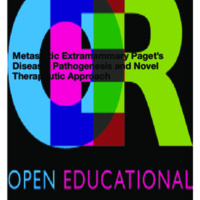Metastatic Extramammary Paget's Disease: Pathogenesis and Novel Therapeutic Approach
Dublin Core
Description
Extramammary Paget's disease (EMPD) is a rare, slow-growing, cutaneous adenocarcinoma that usually originates in the anogenital area and axillae outside the mammary glands. EMPD mostly progresses slowly and is often diagnosed as carcinoma in situ; however, upon becoming invasive, it promptly and frequently metastasizes to regional lymph nodes, leading to subsequent distant metastasis. To date, several chemotherapy regimens have been used to treat metastatic EMPD; however, they present limited effect and patients with distant metastasis exhibit a poor prognosis. Recently, basic and translational investigative research has elucidated factors and molecular mechanisms underlying the promotion of metastasis, which can lead to targeted therapy-based emerging treatment strategies. Here, we aim to discuss current therapies and their limitations; advancements in illustrating mechanisms promoting invasion, migration, and proliferation of EMPD tumor cells; and future therapeutic approaches for metastatic EMPD that may enhance clinical outcomes.
Creator
Source
https://escholarship.umassmed.edu/cgi/viewcontent.cgi?article=4366&context=oapubs
Publisher
Date
2018
Contributor
Baihaqi
Rights
Creative Commons
Format
PDF
Language
English
Type
Files
Collection
Citation
Keitaro Fukuda, Takeru Funakoshi, “Metastatic Extramammary Paget's Disease: Pathogenesis and Novel Therapeutic Approach,” Open Educational Resources (OER) , accessed December 14, 2025, https://oer.uinsyahada.ac.id/items/show/2723.


